Financial Accounting: Analysis of Corporate Bankruptcies in Australia
VerifiedAdded on 2023/06/07
|10
|2418
|383
Case Study
AI Summary
This case study analyzes three major corporate bankruptcies in Australia: ABC Learning, HIH Insurance, and One Tel, to determine the role of liabilities in their failures. The report identifies poor corporate governance and unethical management practices as key contributing factors, rather than overwhelming liabilities. The analysis highlights flawed growth strategies, compromised board independence, dysfunctional internal controls, and auditor independence issues as common threads. The study also references ASX corporate governance principles and APES 110 ethical codes for accounting professionals, recommending stricter punishments for fraudulent directors and auditors and enhanced independence for non-executive directors. The document is available on Desklib, a platform offering a variety of study resources for students.
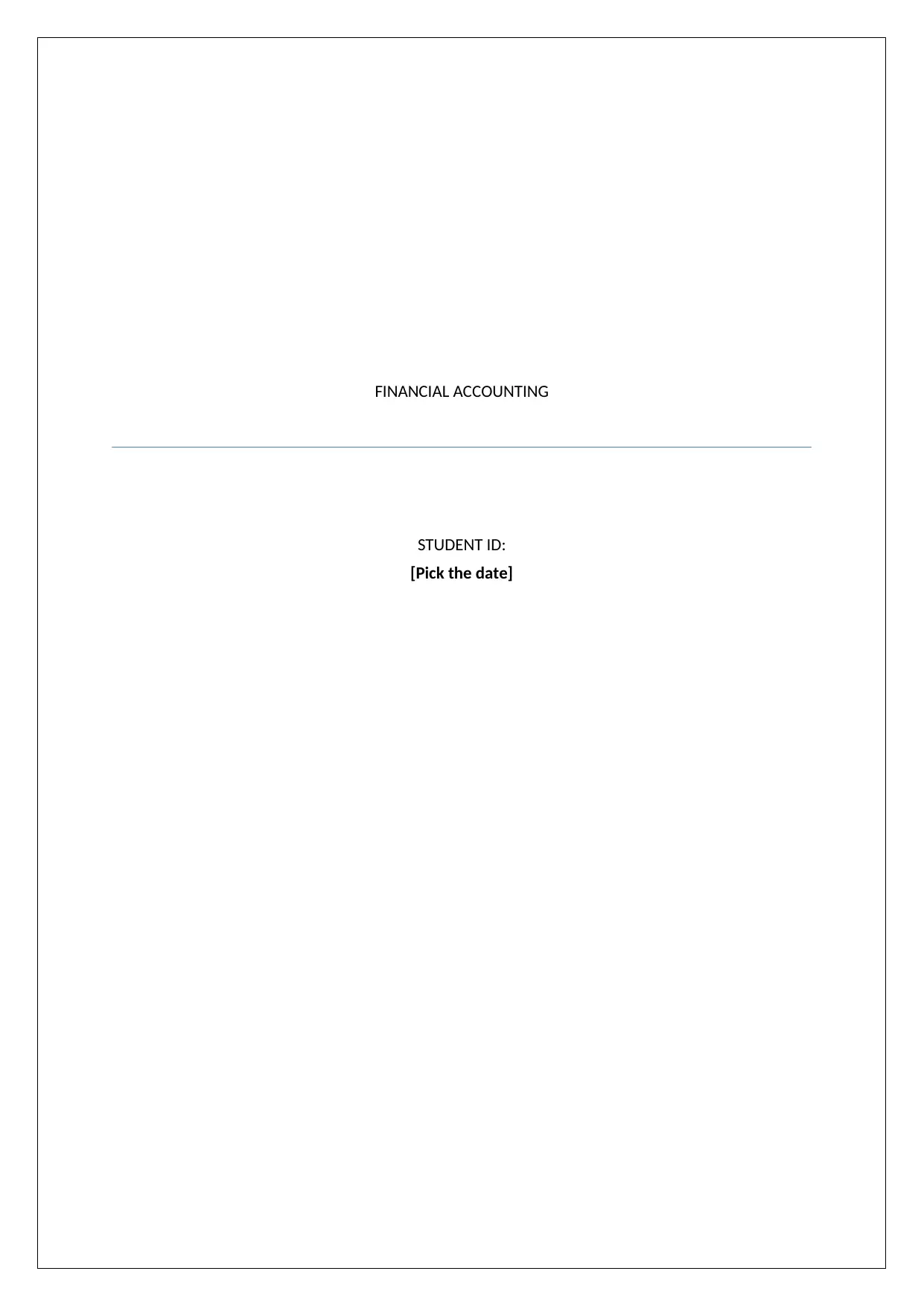
FINANCIAL ACCOUNTING
STUDENT ID:
[Pick the date]
STUDENT ID:
[Pick the date]
Paraphrase This Document
Need a fresh take? Get an instant paraphrase of this document with our AI Paraphraser
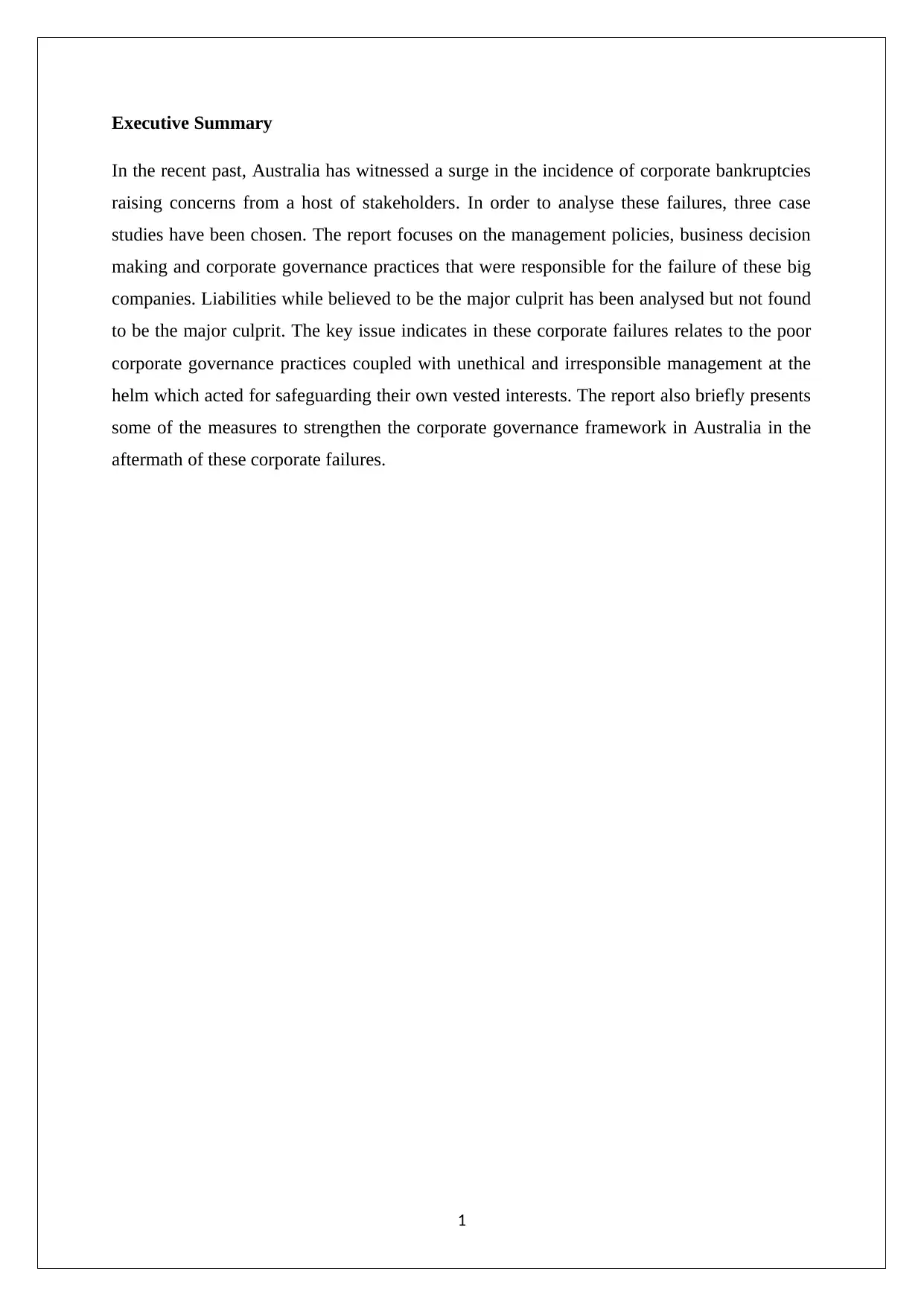
Executive Summary
In the recent past, Australia has witnessed a surge in the incidence of corporate bankruptcies
raising concerns from a host of stakeholders. In order to analyse these failures, three case
studies have been chosen. The report focuses on the management policies, business decision
making and corporate governance practices that were responsible for the failure of these big
companies. Liabilities while believed to be the major culprit has been analysed but not found
to be the major culprit. The key issue indicates in these corporate failures relates to the poor
corporate governance practices coupled with unethical and irresponsible management at the
helm which acted for safeguarding their own vested interests. The report also briefly presents
some of the measures to strengthen the corporate governance framework in Australia in the
aftermath of these corporate failures.
1
In the recent past, Australia has witnessed a surge in the incidence of corporate bankruptcies
raising concerns from a host of stakeholders. In order to analyse these failures, three case
studies have been chosen. The report focuses on the management policies, business decision
making and corporate governance practices that were responsible for the failure of these big
companies. Liabilities while believed to be the major culprit has been analysed but not found
to be the major culprit. The key issue indicates in these corporate failures relates to the poor
corporate governance practices coupled with unethical and irresponsible management at the
helm which acted for safeguarding their own vested interests. The report also briefly presents
some of the measures to strengthen the corporate governance framework in Australia in the
aftermath of these corporate failures.
1
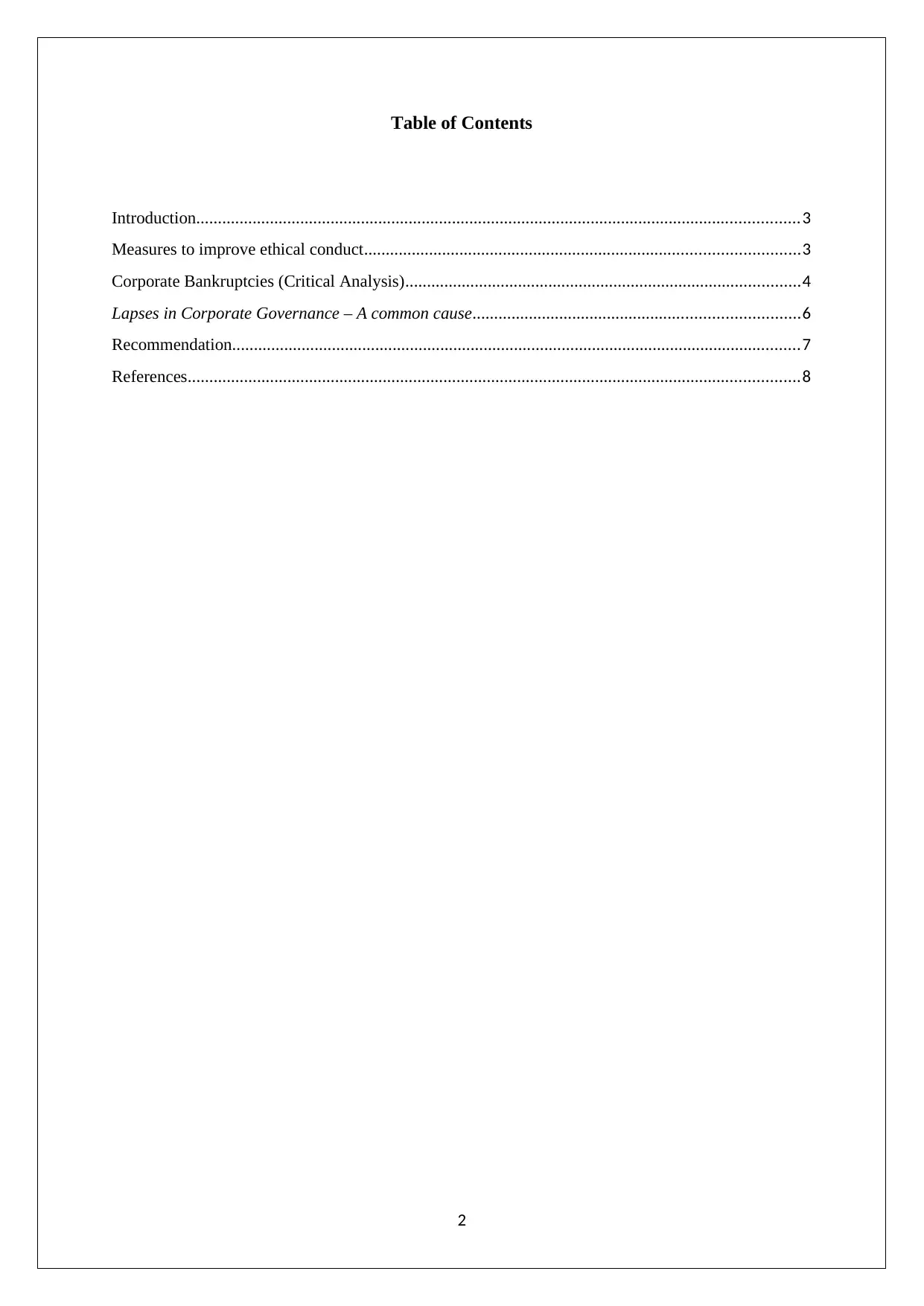
Table of Contents
Introduction...........................................................................................................................................3
Measures to improve ethical conduct....................................................................................................3
Corporate Bankruptcies (Critical Analysis)...........................................................................................4
Lapses in Corporate Governance – A common cause...........................................................................6
Recommendation...................................................................................................................................7
References.............................................................................................................................................8
2
Introduction...........................................................................................................................................3
Measures to improve ethical conduct....................................................................................................3
Corporate Bankruptcies (Critical Analysis)...........................................................................................4
Lapses in Corporate Governance – A common cause...........................................................................6
Recommendation...................................................................................................................................7
References.............................................................................................................................................8
2
⊘ This is a preview!⊘
Do you want full access?
Subscribe today to unlock all pages.

Trusted by 1+ million students worldwide
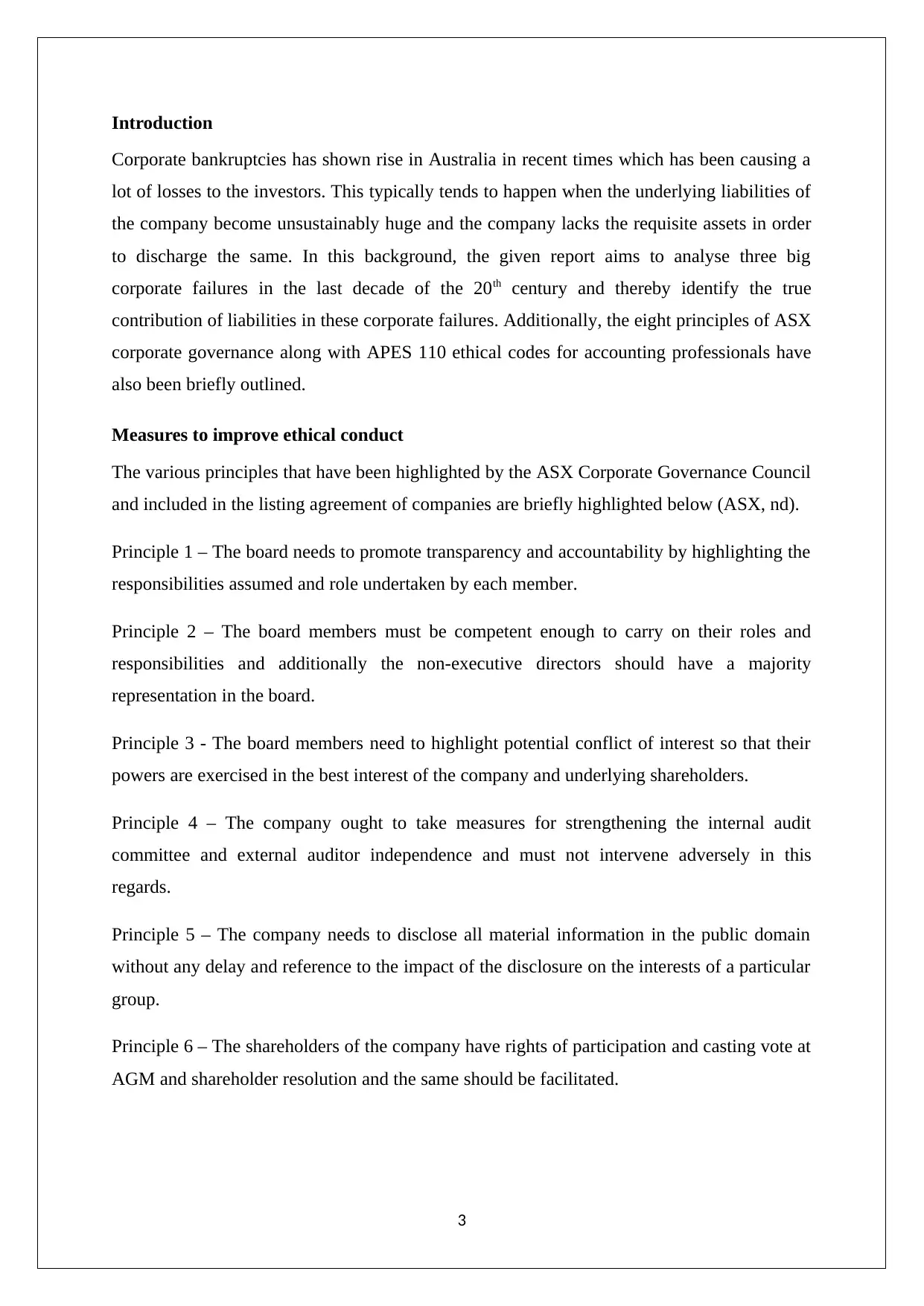
Introduction
Corporate bankruptcies has shown rise in Australia in recent times which has been causing a
lot of losses to the investors. This typically tends to happen when the underlying liabilities of
the company become unsustainably huge and the company lacks the requisite assets in order
to discharge the same. In this background, the given report aims to analyse three big
corporate failures in the last decade of the 20th century and thereby identify the true
contribution of liabilities in these corporate failures. Additionally, the eight principles of ASX
corporate governance along with APES 110 ethical codes for accounting professionals have
also been briefly outlined.
Measures to improve ethical conduct
The various principles that have been highlighted by the ASX Corporate Governance Council
and included in the listing agreement of companies are briefly highlighted below (ASX, nd).
Principle 1 – The board needs to promote transparency and accountability by highlighting the
responsibilities assumed and role undertaken by each member.
Principle 2 – The board members must be competent enough to carry on their roles and
responsibilities and additionally the non-executive directors should have a majority
representation in the board.
Principle 3 - The board members need to highlight potential conflict of interest so that their
powers are exercised in the best interest of the company and underlying shareholders.
Principle 4 – The company ought to take measures for strengthening the internal audit
committee and external auditor independence and must not intervene adversely in this
regards.
Principle 5 – The company needs to disclose all material information in the public domain
without any delay and reference to the impact of the disclosure on the interests of a particular
group.
Principle 6 – The shareholders of the company have rights of participation and casting vote at
AGM and shareholder resolution and the same should be facilitated.
3
Corporate bankruptcies has shown rise in Australia in recent times which has been causing a
lot of losses to the investors. This typically tends to happen when the underlying liabilities of
the company become unsustainably huge and the company lacks the requisite assets in order
to discharge the same. In this background, the given report aims to analyse three big
corporate failures in the last decade of the 20th century and thereby identify the true
contribution of liabilities in these corporate failures. Additionally, the eight principles of ASX
corporate governance along with APES 110 ethical codes for accounting professionals have
also been briefly outlined.
Measures to improve ethical conduct
The various principles that have been highlighted by the ASX Corporate Governance Council
and included in the listing agreement of companies are briefly highlighted below (ASX, nd).
Principle 1 – The board needs to promote transparency and accountability by highlighting the
responsibilities assumed and role undertaken by each member.
Principle 2 – The board members must be competent enough to carry on their roles and
responsibilities and additionally the non-executive directors should have a majority
representation in the board.
Principle 3 - The board members need to highlight potential conflict of interest so that their
powers are exercised in the best interest of the company and underlying shareholders.
Principle 4 – The company ought to take measures for strengthening the internal audit
committee and external auditor independence and must not intervene adversely in this
regards.
Principle 5 – The company needs to disclose all material information in the public domain
without any delay and reference to the impact of the disclosure on the interests of a particular
group.
Principle 6 – The shareholders of the company have rights of participation and casting vote at
AGM and shareholder resolution and the same should be facilitated.
3
Paraphrase This Document
Need a fresh take? Get an instant paraphrase of this document with our AI Paraphraser
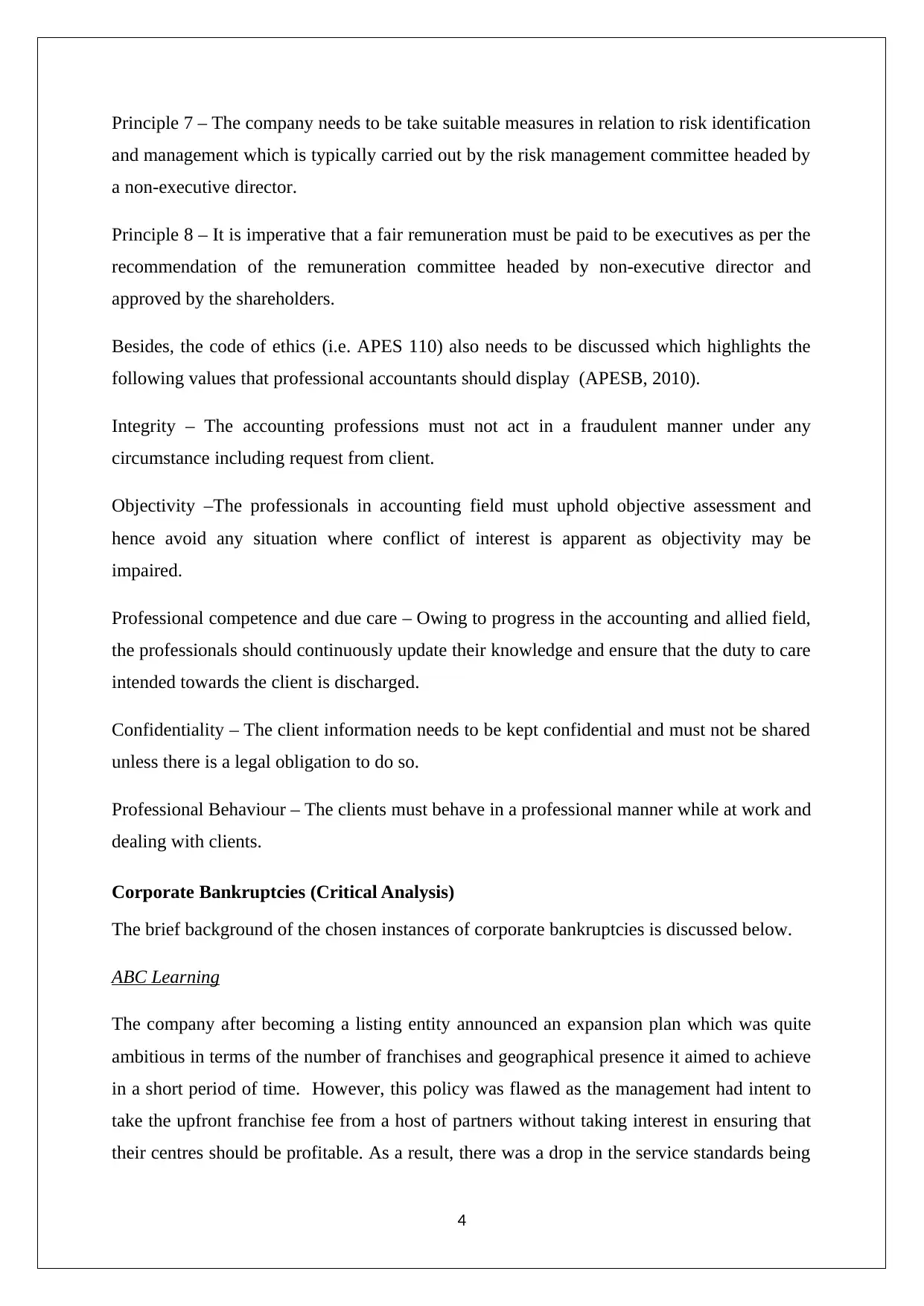
Principle 7 – The company needs to be take suitable measures in relation to risk identification
and management which is typically carried out by the risk management committee headed by
a non-executive director.
Principle 8 – It is imperative that a fair remuneration must be paid to be executives as per the
recommendation of the remuneration committee headed by non-executive director and
approved by the shareholders.
Besides, the code of ethics (i.e. APES 110) also needs to be discussed which highlights the
following values that professional accountants should display (APESB, 2010).
Integrity – The accounting professions must not act in a fraudulent manner under any
circumstance including request from client.
Objectivity –The professionals in accounting field must uphold objective assessment and
hence avoid any situation where conflict of interest is apparent as objectivity may be
impaired.
Professional competence and due care – Owing to progress in the accounting and allied field,
the professionals should continuously update their knowledge and ensure that the duty to care
intended towards the client is discharged.
Confidentiality – The client information needs to be kept confidential and must not be shared
unless there is a legal obligation to do so.
Professional Behaviour – The clients must behave in a professional manner while at work and
dealing with clients.
Corporate Bankruptcies (Critical Analysis)
The brief background of the chosen instances of corporate bankruptcies is discussed below.
ABC Learning
The company after becoming a listing entity announced an expansion plan which was quite
ambitious in terms of the number of franchises and geographical presence it aimed to achieve
in a short period of time. However, this policy was flawed as the management had intent to
take the upfront franchise fee from a host of partners without taking interest in ensuring that
their centres should be profitable. As a result, there was a drop in the service standards being
4
and management which is typically carried out by the risk management committee headed by
a non-executive director.
Principle 8 – It is imperative that a fair remuneration must be paid to be executives as per the
recommendation of the remuneration committee headed by non-executive director and
approved by the shareholders.
Besides, the code of ethics (i.e. APES 110) also needs to be discussed which highlights the
following values that professional accountants should display (APESB, 2010).
Integrity – The accounting professions must not act in a fraudulent manner under any
circumstance including request from client.
Objectivity –The professionals in accounting field must uphold objective assessment and
hence avoid any situation where conflict of interest is apparent as objectivity may be
impaired.
Professional competence and due care – Owing to progress in the accounting and allied field,
the professionals should continuously update their knowledge and ensure that the duty to care
intended towards the client is discharged.
Confidentiality – The client information needs to be kept confidential and must not be shared
unless there is a legal obligation to do so.
Professional Behaviour – The clients must behave in a professional manner while at work and
dealing with clients.
Corporate Bankruptcies (Critical Analysis)
The brief background of the chosen instances of corporate bankruptcies is discussed below.
ABC Learning
The company after becoming a listing entity announced an expansion plan which was quite
ambitious in terms of the number of franchises and geographical presence it aimed to achieve
in a short period of time. However, this policy was flawed as the management had intent to
take the upfront franchise fee from a host of partners without taking interest in ensuring that
their centres should be profitable. As a result, there was a drop in the service standards being
4
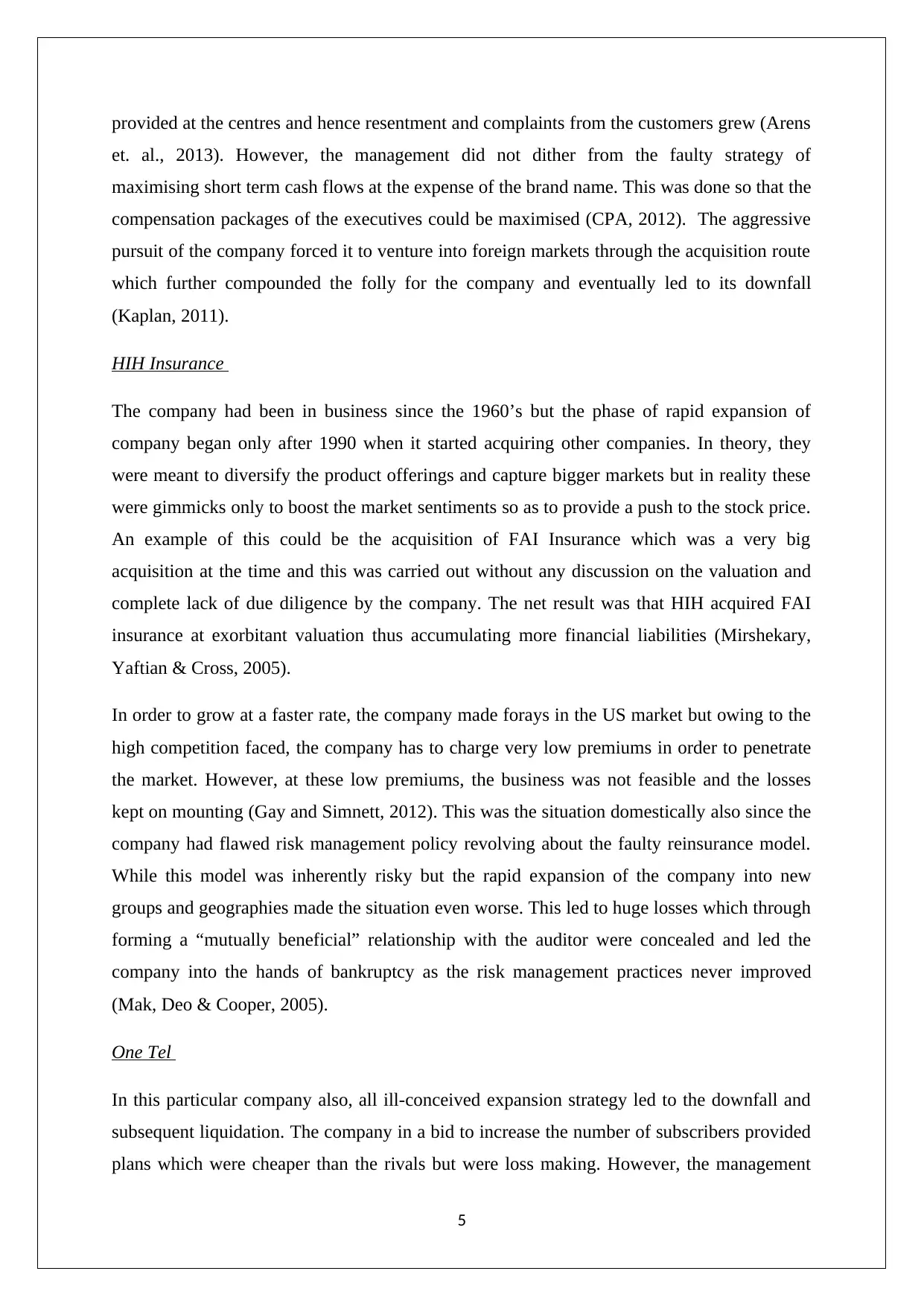
provided at the centres and hence resentment and complaints from the customers grew (Arens
et. al., 2013). However, the management did not dither from the faulty strategy of
maximising short term cash flows at the expense of the brand name. This was done so that the
compensation packages of the executives could be maximised (CPA, 2012). The aggressive
pursuit of the company forced it to venture into foreign markets through the acquisition route
which further compounded the folly for the company and eventually led to its downfall
(Kaplan, 2011).
HIH Insurance
The company had been in business since the 1960’s but the phase of rapid expansion of
company began only after 1990 when it started acquiring other companies. In theory, they
were meant to diversify the product offerings and capture bigger markets but in reality these
were gimmicks only to boost the market sentiments so as to provide a push to the stock price.
An example of this could be the acquisition of FAI Insurance which was a very big
acquisition at the time and this was carried out without any discussion on the valuation and
complete lack of due diligence by the company. The net result was that HIH acquired FAI
insurance at exorbitant valuation thus accumulating more financial liabilities (Mirshekary,
Yaftian & Cross, 2005).
In order to grow at a faster rate, the company made forays in the US market but owing to the
high competition faced, the company has to charge very low premiums in order to penetrate
the market. However, at these low premiums, the business was not feasible and the losses
kept on mounting (Gay and Simnett, 2012). This was the situation domestically also since the
company had flawed risk management policy revolving about the faulty reinsurance model.
While this model was inherently risky but the rapid expansion of the company into new
groups and geographies made the situation even worse. This led to huge losses which through
forming a “mutually beneficial” relationship with the auditor were concealed and led the
company into the hands of bankruptcy as the risk management practices never improved
(Mak, Deo & Cooper, 2005).
One Tel
In this particular company also, all ill-conceived expansion strategy led to the downfall and
subsequent liquidation. The company in a bid to increase the number of subscribers provided
plans which were cheaper than the rivals but were loss making. However, the management
5
et. al., 2013). However, the management did not dither from the faulty strategy of
maximising short term cash flows at the expense of the brand name. This was done so that the
compensation packages of the executives could be maximised (CPA, 2012). The aggressive
pursuit of the company forced it to venture into foreign markets through the acquisition route
which further compounded the folly for the company and eventually led to its downfall
(Kaplan, 2011).
HIH Insurance
The company had been in business since the 1960’s but the phase of rapid expansion of
company began only after 1990 when it started acquiring other companies. In theory, they
were meant to diversify the product offerings and capture bigger markets but in reality these
were gimmicks only to boost the market sentiments so as to provide a push to the stock price.
An example of this could be the acquisition of FAI Insurance which was a very big
acquisition at the time and this was carried out without any discussion on the valuation and
complete lack of due diligence by the company. The net result was that HIH acquired FAI
insurance at exorbitant valuation thus accumulating more financial liabilities (Mirshekary,
Yaftian & Cross, 2005).
In order to grow at a faster rate, the company made forays in the US market but owing to the
high competition faced, the company has to charge very low premiums in order to penetrate
the market. However, at these low premiums, the business was not feasible and the losses
kept on mounting (Gay and Simnett, 2012). This was the situation domestically also since the
company had flawed risk management policy revolving about the faulty reinsurance model.
While this model was inherently risky but the rapid expansion of the company into new
groups and geographies made the situation even worse. This led to huge losses which through
forming a “mutually beneficial” relationship with the auditor were concealed and led the
company into the hands of bankruptcy as the risk management practices never improved
(Mak, Deo & Cooper, 2005).
One Tel
In this particular company also, all ill-conceived expansion strategy led to the downfall and
subsequent liquidation. The company in a bid to increase the number of subscribers provided
plans which were cheaper than the rivals but were loss making. However, the management
5
⊘ This is a preview!⊘
Do you want full access?
Subscribe today to unlock all pages.

Trusted by 1+ million students worldwide
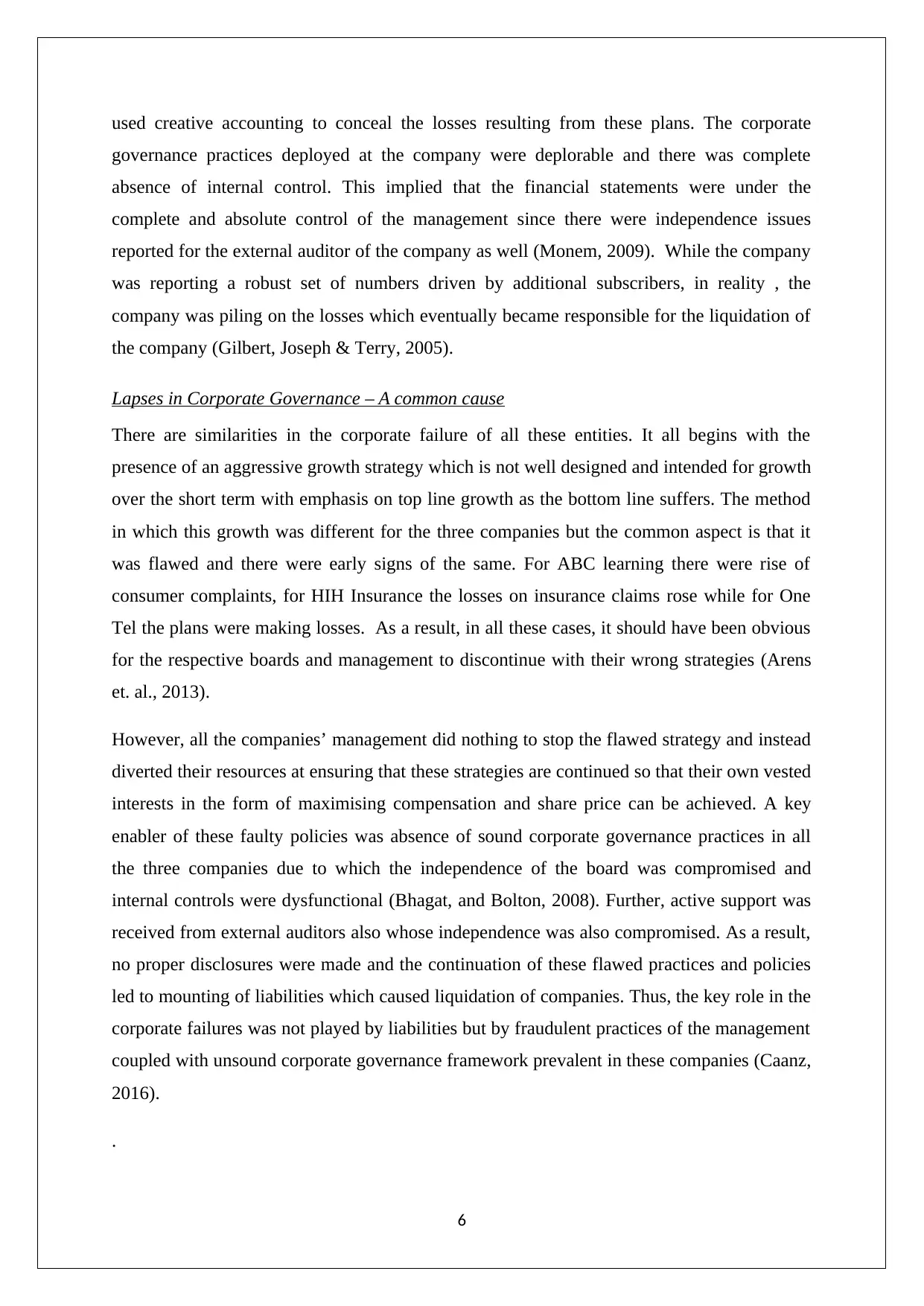
used creative accounting to conceal the losses resulting from these plans. The corporate
governance practices deployed at the company were deplorable and there was complete
absence of internal control. This implied that the financial statements were under the
complete and absolute control of the management since there were independence issues
reported for the external auditor of the company as well (Monem, 2009). While the company
was reporting a robust set of numbers driven by additional subscribers, in reality , the
company was piling on the losses which eventually became responsible for the liquidation of
the company (Gilbert, Joseph & Terry, 2005).
Lapses in Corporate Governance – A common cause
There are similarities in the corporate failure of all these entities. It all begins with the
presence of an aggressive growth strategy which is not well designed and intended for growth
over the short term with emphasis on top line growth as the bottom line suffers. The method
in which this growth was different for the three companies but the common aspect is that it
was flawed and there were early signs of the same. For ABC learning there were rise of
consumer complaints, for HIH Insurance the losses on insurance claims rose while for One
Tel the plans were making losses. As a result, in all these cases, it should have been obvious
for the respective boards and management to discontinue with their wrong strategies (Arens
et. al., 2013).
However, all the companies’ management did nothing to stop the flawed strategy and instead
diverted their resources at ensuring that these strategies are continued so that their own vested
interests in the form of maximising compensation and share price can be achieved. A key
enabler of these faulty policies was absence of sound corporate governance practices in all
the three companies due to which the independence of the board was compromised and
internal controls were dysfunctional (Bhagat, and Bolton, 2008). Further, active support was
received from external auditors also whose independence was also compromised. As a result,
no proper disclosures were made and the continuation of these flawed practices and policies
led to mounting of liabilities which caused liquidation of companies. Thus, the key role in the
corporate failures was not played by liabilities but by fraudulent practices of the management
coupled with unsound corporate governance framework prevalent in these companies (Caanz,
2016).
.
6
governance practices deployed at the company were deplorable and there was complete
absence of internal control. This implied that the financial statements were under the
complete and absolute control of the management since there were independence issues
reported for the external auditor of the company as well (Monem, 2009). While the company
was reporting a robust set of numbers driven by additional subscribers, in reality , the
company was piling on the losses which eventually became responsible for the liquidation of
the company (Gilbert, Joseph & Terry, 2005).
Lapses in Corporate Governance – A common cause
There are similarities in the corporate failure of all these entities. It all begins with the
presence of an aggressive growth strategy which is not well designed and intended for growth
over the short term with emphasis on top line growth as the bottom line suffers. The method
in which this growth was different for the three companies but the common aspect is that it
was flawed and there were early signs of the same. For ABC learning there were rise of
consumer complaints, for HIH Insurance the losses on insurance claims rose while for One
Tel the plans were making losses. As a result, in all these cases, it should have been obvious
for the respective boards and management to discontinue with their wrong strategies (Arens
et. al., 2013).
However, all the companies’ management did nothing to stop the flawed strategy and instead
diverted their resources at ensuring that these strategies are continued so that their own vested
interests in the form of maximising compensation and share price can be achieved. A key
enabler of these faulty policies was absence of sound corporate governance practices in all
the three companies due to which the independence of the board was compromised and
internal controls were dysfunctional (Bhagat, and Bolton, 2008). Further, active support was
received from external auditors also whose independence was also compromised. As a result,
no proper disclosures were made and the continuation of these flawed practices and policies
led to mounting of liabilities which caused liquidation of companies. Thus, the key role in the
corporate failures was not played by liabilities but by fraudulent practices of the management
coupled with unsound corporate governance framework prevalent in these companies (Caanz,
2016).
.
6
Paraphrase This Document
Need a fresh take? Get an instant paraphrase of this document with our AI Paraphraser
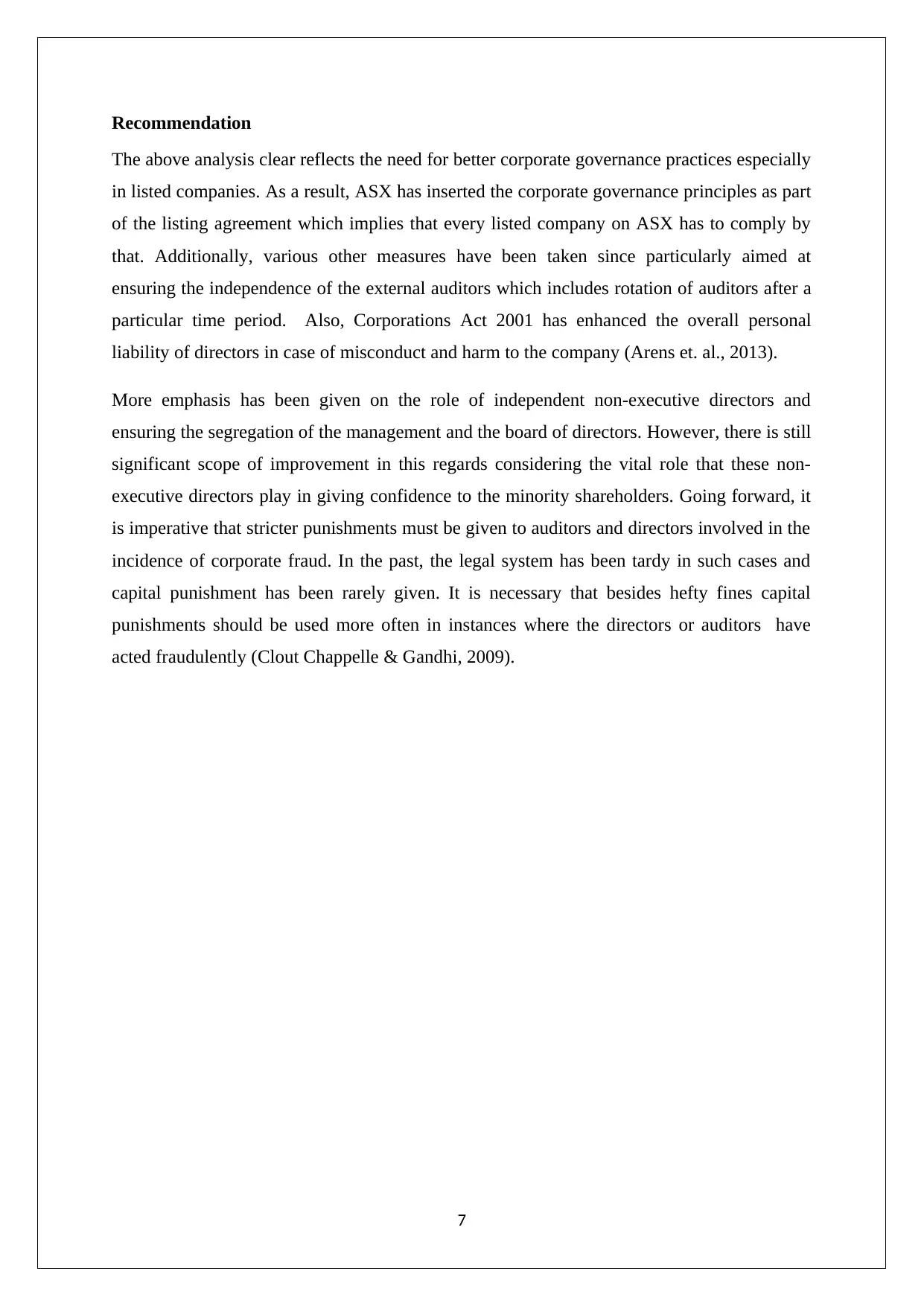
Recommendation
The above analysis clear reflects the need for better corporate governance practices especially
in listed companies. As a result, ASX has inserted the corporate governance principles as part
of the listing agreement which implies that every listed company on ASX has to comply by
that. Additionally, various other measures have been taken since particularly aimed at
ensuring the independence of the external auditors which includes rotation of auditors after a
particular time period. Also, Corporations Act 2001 has enhanced the overall personal
liability of directors in case of misconduct and harm to the company (Arens et. al., 2013).
More emphasis has been given on the role of independent non-executive directors and
ensuring the segregation of the management and the board of directors. However, there is still
significant scope of improvement in this regards considering the vital role that these non-
executive directors play in giving confidence to the minority shareholders. Going forward, it
is imperative that stricter punishments must be given to auditors and directors involved in the
incidence of corporate fraud. In the past, the legal system has been tardy in such cases and
capital punishment has been rarely given. It is necessary that besides hefty fines capital
punishments should be used more often in instances where the directors or auditors have
acted fraudulently (Clout Chappelle & Gandhi, 2009).
7
The above analysis clear reflects the need for better corporate governance practices especially
in listed companies. As a result, ASX has inserted the corporate governance principles as part
of the listing agreement which implies that every listed company on ASX has to comply by
that. Additionally, various other measures have been taken since particularly aimed at
ensuring the independence of the external auditors which includes rotation of auditors after a
particular time period. Also, Corporations Act 2001 has enhanced the overall personal
liability of directors in case of misconduct and harm to the company (Arens et. al., 2013).
More emphasis has been given on the role of independent non-executive directors and
ensuring the segregation of the management and the board of directors. However, there is still
significant scope of improvement in this regards considering the vital role that these non-
executive directors play in giving confidence to the minority shareholders. Going forward, it
is imperative that stricter punishments must be given to auditors and directors involved in the
incidence of corporate fraud. In the past, the legal system has been tardy in such cases and
capital punishment has been rarely given. It is necessary that besides hefty fines capital
punishments should be used more often in instances where the directors or auditors have
acted fraudulently (Clout Chappelle & Gandhi, 2009).
7
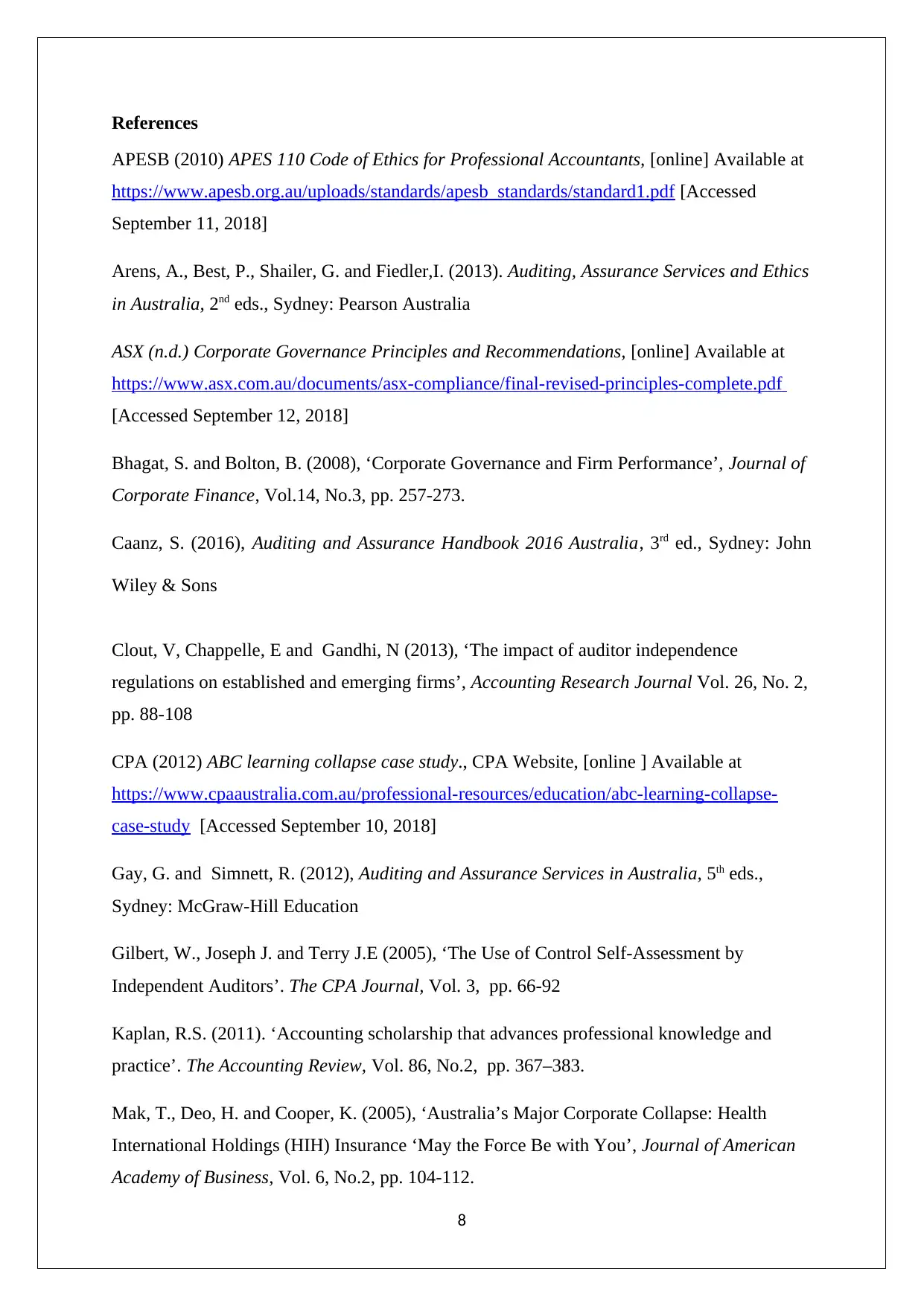
References
APESB (2010) APES 110 Code of Ethics for Professional Accountants, [online] Available at
https://www.apesb.org.au/uploads/standards/apesb_standards/standard1.pdf [Accessed
September 11, 2018]
Arens, A., Best, P., Shailer, G. and Fiedler,I. (2013). Auditing, Assurance Services and Ethics
in Australia, 2nd eds., Sydney: Pearson Australia
ASX (n.d.) Corporate Governance Principles and Recommendations, [online] Available at
https://www.asx.com.au/documents/asx-compliance/final-revised-principles-complete.pdf
[Accessed September 12, 2018]
Bhagat, S. and Bolton, B. (2008), ‘Corporate Governance and Firm Performance’, Journal of
Corporate Finance, Vol.14, No.3, pp. 257-273.
Caanz, S. (2016), Auditing and Assurance Handbook 2016 Australia, 3rd ed., Sydney: John
Wiley & Sons
Clout, V, Chappelle, E and Gandhi, N (2013), ‘The impact of auditor independence
regulations on established and emerging firms’, Accounting Research Journal Vol. 26, No. 2,
pp. 88-108
CPA (2012) ABC learning collapse case study., CPA Website, [online ] Available at
https://www.cpaaustralia.com.au/professional-resources/education/abc-learning-collapse-
case-study [Accessed September 10, 2018]
Gay, G. and Simnett, R. (2012), Auditing and Assurance Services in Australia, 5th eds.,
Sydney: McGraw-Hill Education
Gilbert, W., Joseph J. and Terry J.E (2005), ‘The Use of Control Self-Assessment by
Independent Auditors’. The CPA Journal, Vol. 3, pp. 66-92
Kaplan, R.S. (2011). ‘Accounting scholarship that advances professional knowledge and
practice’. The Accounting Review, Vol. 86, No.2, pp. 367–383.
Mak, T., Deo, H. and Cooper, K. (2005), ‘Australia’s Major Corporate Collapse: Health
International Holdings (HIH) Insurance ‘May the Force Be with You’, Journal of American
Academy of Business, Vol. 6, No.2, pp. 104-112.
8
APESB (2010) APES 110 Code of Ethics for Professional Accountants, [online] Available at
https://www.apesb.org.au/uploads/standards/apesb_standards/standard1.pdf [Accessed
September 11, 2018]
Arens, A., Best, P., Shailer, G. and Fiedler,I. (2013). Auditing, Assurance Services and Ethics
in Australia, 2nd eds., Sydney: Pearson Australia
ASX (n.d.) Corporate Governance Principles and Recommendations, [online] Available at
https://www.asx.com.au/documents/asx-compliance/final-revised-principles-complete.pdf
[Accessed September 12, 2018]
Bhagat, S. and Bolton, B. (2008), ‘Corporate Governance and Firm Performance’, Journal of
Corporate Finance, Vol.14, No.3, pp. 257-273.
Caanz, S. (2016), Auditing and Assurance Handbook 2016 Australia, 3rd ed., Sydney: John
Wiley & Sons
Clout, V, Chappelle, E and Gandhi, N (2013), ‘The impact of auditor independence
regulations on established and emerging firms’, Accounting Research Journal Vol. 26, No. 2,
pp. 88-108
CPA (2012) ABC learning collapse case study., CPA Website, [online ] Available at
https://www.cpaaustralia.com.au/professional-resources/education/abc-learning-collapse-
case-study [Accessed September 10, 2018]
Gay, G. and Simnett, R. (2012), Auditing and Assurance Services in Australia, 5th eds.,
Sydney: McGraw-Hill Education
Gilbert, W., Joseph J. and Terry J.E (2005), ‘The Use of Control Self-Assessment by
Independent Auditors’. The CPA Journal, Vol. 3, pp. 66-92
Kaplan, R.S. (2011). ‘Accounting scholarship that advances professional knowledge and
practice’. The Accounting Review, Vol. 86, No.2, pp. 367–383.
Mak, T., Deo, H. and Cooper, K. (2005), ‘Australia’s Major Corporate Collapse: Health
International Holdings (HIH) Insurance ‘May the Force Be with You’, Journal of American
Academy of Business, Vol. 6, No.2, pp. 104-112.
8
⊘ This is a preview!⊘
Do you want full access?
Subscribe today to unlock all pages.

Trusted by 1+ million students worldwide
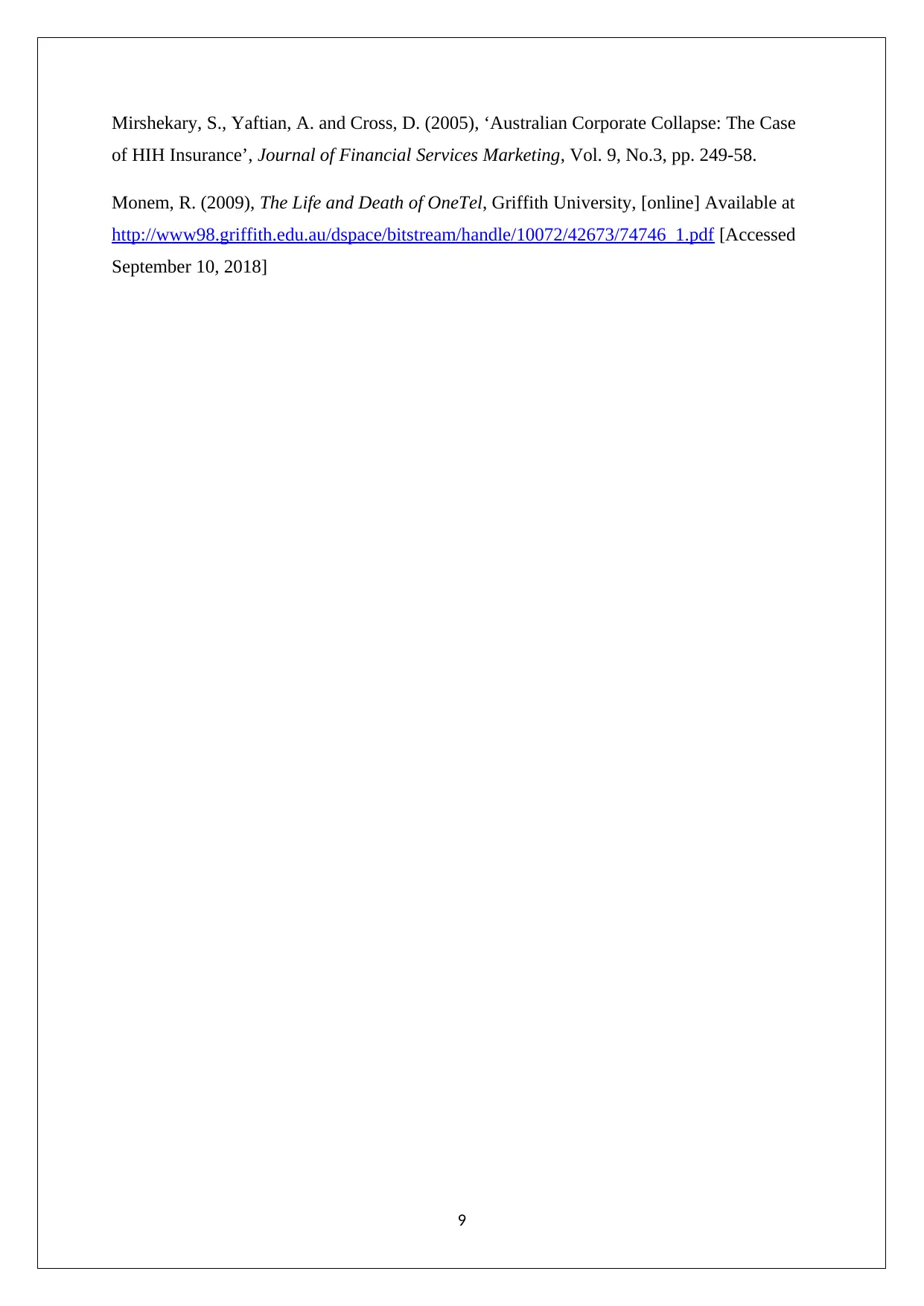
Mirshekary, S., Yaftian, A. and Cross, D. (2005), ‘Australian Corporate Collapse: The Case
of HIH Insurance’, Journal of Financial Services Marketing, Vol. 9, No.3, pp. 249-58.
Monem, R. (2009), The Life and Death of OneTel, Griffith University, [online] Available at
http://www98.griffith.edu.au/dspace/bitstream/handle/10072/42673/74746_1.pdf [Accessed
September 10, 2018]
9
of HIH Insurance’, Journal of Financial Services Marketing, Vol. 9, No.3, pp. 249-58.
Monem, R. (2009), The Life and Death of OneTel, Griffith University, [online] Available at
http://www98.griffith.edu.au/dspace/bitstream/handle/10072/42673/74746_1.pdf [Accessed
September 10, 2018]
9
1 out of 10
Related Documents
Your All-in-One AI-Powered Toolkit for Academic Success.
+13062052269
info@desklib.com
Available 24*7 on WhatsApp / Email
![[object Object]](/_next/static/media/star-bottom.7253800d.svg)
Unlock your academic potential
Copyright © 2020–2025 A2Z Services. All Rights Reserved. Developed and managed by ZUCOL.





